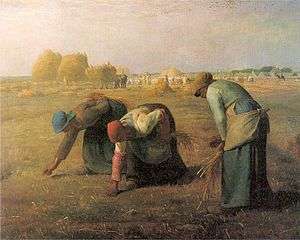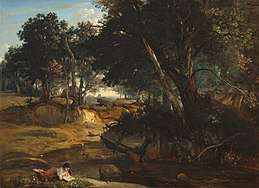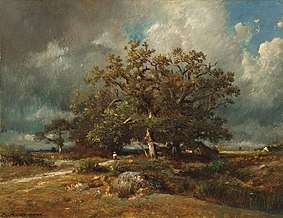Barbizon school
The Barbizon school of painters were part of an art movement towards Realism in art, which arose in the context of the dominant Romantic Movement of the time. The Barbizon school was active roughly from 1830 through 1870. It takes its name from the village of Barbizon, France, near the Forest of Fontainebleau, where many of the artists gathered. Some of the most prominent features of this school are its tonal qualities, color, loose brushwork, and softness of form.[1]

History
In 1824 the Salon de Paris exhibited works of John Constable, an English painter. His rural scenes influenced some of the younger artists of the time, moving them to abandon formalism and to draw inspiration directly from nature. Natural scenes became the subjects of their paintings rather than mere backdrops to dramatic events. During the Revolutions of 1848 artists gathered at Barbizon to follow Constable's ideas, making nature the subject of their paintings. The French landscape became a major theme of the Barbizon painters.[2]
The leaders of the Barbizon school were Théodore Rousseau, Jean-François Millet, and Charles-François Daubigny; other members included Jules Dupré, Constant Troyon, Charles Jacque, Narcisse Virgilio Díaz, Pierre Emmanuel Damoye, Charles Olivier de Penne, Henri Harpignies, Paul-Emmanuel Péraire, Gabriel-Hippolyte Lebas, Albert Charpin, Félix Ziem, François-Louis Français, Émile van Marcke, and Alexandre Defaux.
Millet extended the idea from landscape to figures — peasant figures, scenes of peasant life, and work in the fields. In The Gleaners (1857), for example, Millet portrays three peasant women working at the harvest. Gleaners are poor people who are permitted to gather the remains after the owners of the field complete the main harvest. The owners (portrayed as wealthy) and their laborers are seen in the back of the painting. Millet shifted the focus and the subject matter from the rich and prominent to those at the bottom of the social ladders. To emphasize their anonymity and marginalized position, he hid their faces. The women's bowed bodies represent their everyday hard work.
In the spring of 1829, Jean-Baptiste-Camille Corot came to Barbizon to paint in the Forest of Fontainebleau, he had first painted in the forest at Chailly in 1822. He returned to Barbizon in the autumn of 1830 and in the summer of 1831, where he made drawings and oil studies, from which he made a painting intended for the Salon of 1830; "View of the Forest of Fontainebleau'" (now in the National Gallery in Washington) and, for the salon of 1831, another "View of the Forest of Fontainebleau"'. While there he met the members of the Barbizon school; Théodore Rousseau, Paul Huet, Constant Troyon, Jean-François Millet, and the young Charles-François Daubigny.[3]
During the late 1860s, the Barbizon painters attracted the attention of a younger generation of French artists studying in Paris. Several of those artists visited Fontainebleau Forest to paint the landscape, including Claude Monet, Pierre-Auguste Renoir, Alfred Sisley and Frédéric Bazille.[4] In the 1870s those artists, among others, developed the art movement called Impressionism and practiced plein air painting.
The Post-Impressionist painter Vincent Van Gogh studied and copied several of the Barbizon painters as well, including 21 copies of paintings by Millet. He copied Millet more than any other artist. He also did three paintings in Daubigny's Garden.
Both Théodore Rousseau (1867) and Jean-François Millet (1875) died at Barbizon.
Influence in Europe
Painters in other countries were also influenced by this art. Beginning in the late nineteenth century, many artists came to Paris from Austria-Hungary to study the new movements. For instance, the Hungarian painter János Thorma studied in Paris as a young man. In 1896 he was one of the founders of the Nagybánya artists' colony in what is now Baia Mare, Romania, which brought impressionism to Hungary. In 2013 the Hungarian National Gallery opens a major retrospective of his work, entitled, ''János Thorma, the Painter of the Hungarian Barbizon, 8 February - 19 May 2013, Hungarian National Gallery[5]
Influence in America
The Barbizon painters also had a profound impact on landscape painting in the United States. This included the development of the American Barbizon school by William Morris Hunt. Several artists who were also in, or contemporary to, the Hudson River School studied Barbizon paintings for their loose brushwork and emotional impact. A notable example is George Innes, who sought to emulate the works of Rousseau.[6] Paintings from the Barbizon school also influenced landscape painting in California. The artist Percy Gray carefully studied works by Rousseau and other painters which he saw in traveling exhibitions to inform his own paintings of California hills and coastline.[7] The influence of the Barbizon painters may be seen in the extraordinary sporting dog paintings of Percival Rosseau (1859-1937), who grew up in Louisiana and studied at the Academie Julien.
Gallery
 Jean-Baptiste-Camille Corot, View of the Forest of Fontainebleau (1830)
Jean-Baptiste-Camille Corot, View of the Forest of Fontainebleau (1830) Théodore Rousseau, Barbizon landscape, ca. 1850, Pushkin Museum, Moscow
Théodore Rousseau, Barbizon landscape, ca. 1850, Pushkin Museum, Moscow- Charles-François Daubigny Rising Moon in Barbizon, c. 1850s, Museum of Fine Arts, Ghent
 Constant Troyon, The Ford, 1852, Louvre
Constant Troyon, The Ford, 1852, Louvre Charles Jacque, The Old Forest, c. 1860s, Brooklyn Museum
Charles Jacque, The Old Forest, c. 1860s, Brooklyn Museum Narcisse Virgilio Díaz, Forest of Fontainebleau, 1868, Dallas Museum of Art
Narcisse Virgilio Díaz, Forest of Fontainebleau, 1868, Dallas Museum of Art Jules Dupré, The Old Oak, c. 1870, National Gallery of Art, Washington, DC.
Jules Dupré, The Old Oak, c. 1870, National Gallery of Art, Washington, DC.
Related artists
- Karl Bodmer
- Eugène Boudin
- Hippolyte Boulenger
- Gustave Courbet
- Antonio Fontanesi
- Nicolae Grigorescu
- Winckworth Allan Gay
- H. I. Marlatt
- Adolphe Joseph Thomas Monticelli
- László Paál
See also
- American Barbizon school
- Art colony
- Naturalism (art)
- Landscape art
- Macchiaioli
References
- Craven, Wayne (1994). American Art: History and Culture. New York: Harry N. Adams, Inc. p. 332.
- Metropolitan Museum of Art timeline
- Pomaréde, Vincent, Le ABCdaire de Corot et le passage français (1996), Flammarion, Paris, (ISBN 2-08-012466-8)
- Heilbrunn Timeline, Metropolitan Museum of Art
- János Thorma, the Painter of the Hungarian Barbizon, 8 February - 19 May 2013, Hungarian National Gallery
- Bell, Adrienne (December 2012). "George Inness (1825–1894)". Metropolitan Museum of Art. Retrieved 18 September 2019.
- Harrison, Alfred; Shields, Scott; et al. (1999). The Legacy of Percy Gray. Carmel Art Association. ISBN 1885666098.
Suggested sources
- Catalogues des Collections des Musees de France. Ministère de la culture. (Catalogs of Collections of Museums of France. Ministry of Culture.)
External links
| Wikiquote has quotations related to: Barbizon school |
| Wikisource has the text of the 1911 Encyclopædia Britannica article Barbizon. |

- Hecht Museum
- Cambridge Art Gallery